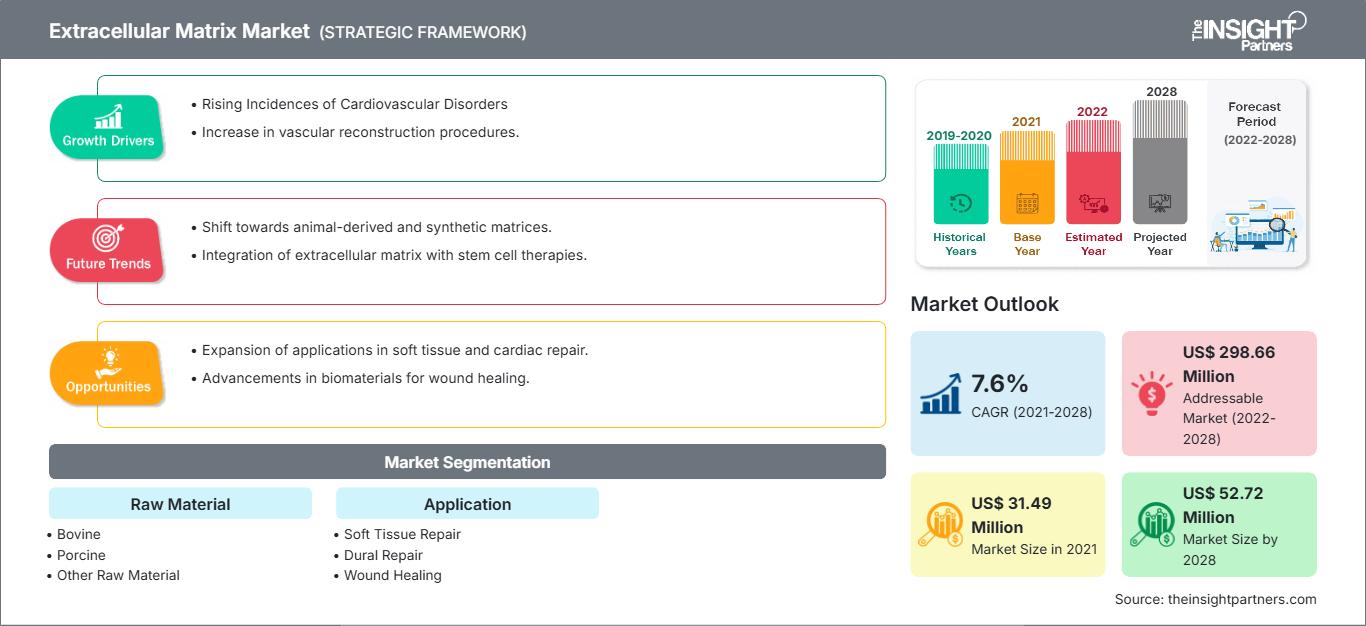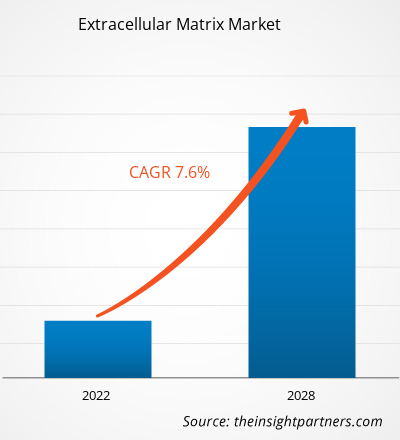Si prevede che il mercato della matrice extracellulare raggiungerà i 52,72 milioni di dollari entro il 2028, rispetto ai 31,49 milioni di dollari del 2021. Si stima una crescita a un CAGR del 7,6% dal 2021 al 2028.
La matrice extracellulare è presente nella superficie esterna dei tessuti e aiuta i tessuti a legare le cellule al collagene. È composta da proteine strutturali, glicoproteine, glicosaminoglicani e proteoglicani. La matrice extracellulare consente alle cellule riceventi di rigenerarsi e, pertanto, viene utilizzata in varie applicazioni, tra cui le procedure di riparazione cardiaca e vascolare. Diversi fattori, come il significativo aumento dell'incidenza di malattie cardiovascolari e traumi e l'aumento delle procedure di ricostruzione vascolare, stanno stimolando la crescita del mercato della matrice extracellulare. Tuttavia, le difficoltà nell'utilizzo della matrice extracellulare decellularizzata ne ostacolano la crescita.
Personalizza questo rapporto in base alle tue esigenze
Potrai personalizzare gratuitamente qualsiasi rapporto, comprese parti di questo rapporto, o analisi a livello di paese, pacchetto dati Excel, oltre a usufruire di grandi offerte e sconti per start-up e università
Mercato della matrice extracellulare: Approfondimenti strategici

-
Ottieni le principali tendenze chiave del mercato di questo rapporto.Questo campione GRATUITO includerà l'analisi dei dati, che vanno dalle tendenze di mercato alle stime e alle previsioni.
Approfondimenti di mercato
L'aumento dell'incidenza di disturbi cardiovascolari e traumi stimola la crescita del mercato della matrice extracellulare
Il significativo aumento dei casi di traumi ortopedici e malattie cardiovascolari è il fattore principale alla base della crescita del mercato globale della matrice extracellulare. Come parte del trattamento, la matrice extracellulare offre diversi benefici nel trattamento di diverse lesioni croniche causate da interventi chirurgici, incidenti, malattie croniche e altri eventi. Inoltre, l'incidenza di insufficienza cardiaca e infarto del miocardio è in aumento tra la popolazione anziana. Il trattamento mininvasivo per queste procedure cardiovascolari richiede la matrice extracellulare. Un paziente affetto da cardiopatia non riesce a ripristinare le proprietà funzionali del tessuto cardiaco. La capacità della matrice extracellulare di rigenerarsi e promuovere la riparazione e la rigenerazione adattiva consente ai pazienti di recuperare le loro normali funzioni. Inoltre, ha mostrato risultati clinici promettenti per l'ingegneria tissutale nel trattamento di malattie cardiovascolari e altre condizioni di salute.
Inoltre, si prevede che l'aumento dell'incidenza delle malattie cardiovascolari stimoli la crescita della matrice extracellulare. Ad esempio, secondo i dati dell'OMS pubblicati nel 2019, si stima che 17,9 milioni di persone siano morte per malattie cardiovascolari nel 2019, pari al 32% di tutti i decessi globali. Di questi decessi, l'85% è stato dovuto ad infarto e ictus. Secondo il rapporto European Cardiovascular Disease Statistics del 2017, in Europa, ogni anno le malattie cardiovascolari (CVD) causano 3,9 milioni di decessi e oltre 1,8 milioni di decessi nell'Unione Europea (UE).
Approfondimenti basati sulle materie prime
In base alla materia prima, il mercato della matrice extracellulare è segmentato in bovino, suino e altre materie prime. Si prevede che il segmento suino deterrà la quota maggiore del mercato, mentre si prevede che il segmento bovino registrerà il CAGR più elevato durante il periodo di previsione.
In base all'applicazione, il mercato della matrice extracellulare è stato segmentato in riparazione dei tessuti molli, riparazione durale, guarigione delle ferite, riparazione cardiaca, riparazione pericardica e riparazione e ricostruzione vascolare. È probabile che il segmento della riparazione dei tessuti molli rappresenti una quota di mercato maggiore nel 2021. Tuttavia, si prevede che il segmento della riparazione e ricostruzione vascolare registrerà un CAGR più elevato sul mercato durante il periodo di previsione.
Diverse aziende che operano nel mercato della matrice extracellulare stanno adottando strategie di marketing, come lanci di prodotti, fusioni e acquisizioni, collaborazioni, innovazioni di prodotto ed espansioni del portafoglio prodotti per espandere la propria presenza a livello mondiale, mantenere il marchio e soddisfare la crescente domanda degli utenti finali.
Approfondimenti regionali sul mercato della matrice extracellulare
Le tendenze regionali e i fattori che influenzano il mercato della matrice extracellulare durante il periodo di previsione sono stati ampiamente spiegati dagli analisti di The Insight Partners. Questa sezione illustra anche i segmenti e la geografia del mercato della matrice extracellulare in Nord America, Europa, Asia-Pacifico, Medio Oriente e Africa, America meridionale e centrale.
Ambito del rapporto di mercato sulla matrice extracellulare
| Attributo del rapporto | Dettagli |
|---|---|
| Dimensioni del mercato in 2021 | US$ 31.49 Million |
| Dimensioni del mercato per 2028 | US$ 52.72 Million |
| CAGR globale (2021 - 2028) | 7.6% |
| Dati storici | 2019-2020 |
| Periodo di previsione | 2022-2028 |
| Segmenti coperti |
By Materia prima
|
| Regioni e paesi coperti |
Nord America
|
| Leader di mercato e profili aziendali chiave |
|
Densità degli attori del mercato della matrice extracellulare: comprendere il suo impatto sulle dinamiche aziendali
Il mercato delle matrici extracellulari è in rapida crescita, trainato dalla crescente domanda degli utenti finali, dovuta a fattori quali l'evoluzione delle preferenze dei consumatori, i progressi tecnologici e una maggiore consapevolezza dei benefici del prodotto. Con l'aumento della domanda, le aziende stanno ampliando la propria offerta, innovando per soddisfare le esigenze dei consumatori e sfruttando le tendenze emergenti, alimentando ulteriormente la crescita del mercato.

- Ottieni il Mercato della matrice extracellulare Panoramica dei principali attori chiave
Profili aziendali
- Anteris
- Aziyo Biologics, Inc
- Coloplast Group
- Cook Biotech, Inc
- DSM Biomedical
- Baxter
- Medtronic
- Merck KGaA
- MTF Biologics
- Smith & Nephew
- Analisi storica (2 anni), anno base, previsione (7 anni) con CAGR
- Analisi PEST e SWOT
- Valore/volume delle dimensioni del mercato - Globale, Regionale, Nazionale
- Industria e panorama competitivo
- Set di dati Excel
Report recenti
Rapporti correlati
Testimonianze
Motivo dell'acquisto
- Processo decisionale informato
- Comprensione delle dinamiche di mercato
- Analisi competitiva
- Analisi dei clienti
- Previsioni di mercato
- Mitigazione del rischio
- Pianificazione strategica
- Giustificazione degli investimenti
- Identificazione dei mercati emergenti
- Miglioramento delle strategie di marketing
- Aumento dell'efficienza operativa
- Allineamento alle tendenze normative






















 Ottieni un campione gratuito per - Mercato della matrice extracellulare
Ottieni un campione gratuito per - Mercato della matrice extracellulare